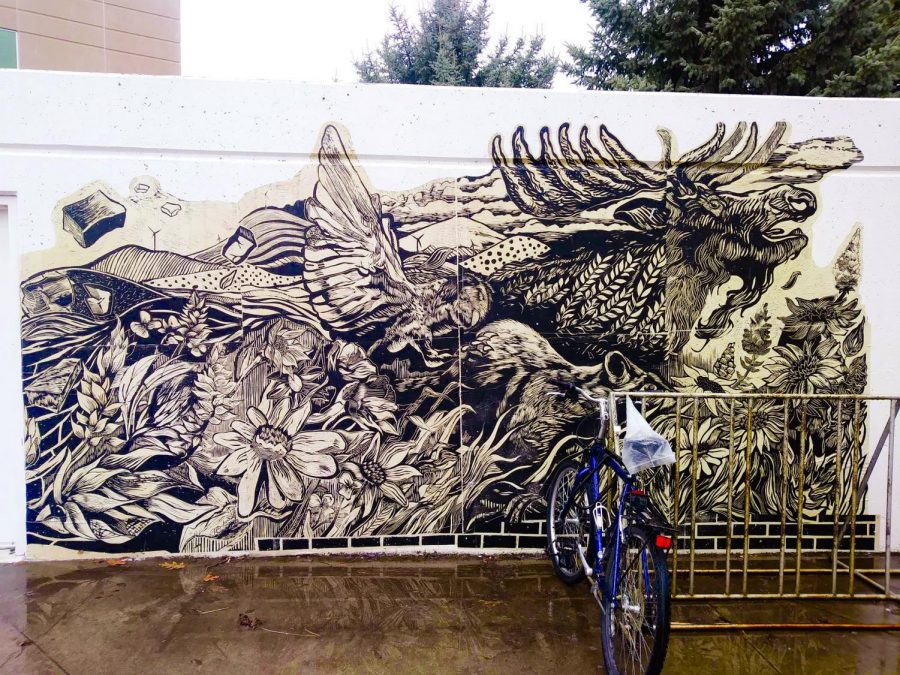Students create monumental mural
Instructor Reinaldo Gil Zambrano guides students through the printmaking process to design a mural. The mural has been placed at WSU, the University of Idaho and outside of the Computing and Engineering Building at EWU | Photo courtesy of Reinaldo Gil Zambrano
May 16, 2018
Nine students with different majors came together under instructor Reinaldo Gil Zambrano’s guidance to create, draw, carve, print and install a 8-by-32-feet mural. The mural was installed at the Rocky Mountain Printmaking Alliance conference April 19-21 at WSU and the University of Idaho.
Gil Zambrano designed and successfully ran an experimental printmaking course last winter quarter. This course took two years of preplanning. Gil Zambrano sent in the application to the conference ahead of time even before the class was constructed.
“I had an idea of doing this project so I sent the application and I sent the proposal and it got accepted,” Gil Zambrano said. “After that it gave more incentive to look for support from the school in order to make it possible.”
Gil Zambrano’s idea was to show students how contribution in really big projects is a necessity when it comes to completing them.
“First of all, I wanted to do something in a really large scale using a traditional media given an unconventional application, more into the street art,” said Gil Zambrano. “I wanted to engage students into the making of this. I wanted to prove that art is this tool that you can use in order to bring people together with a common goal. Disregarding if they have the experience or not.”
In the printmaking process everything starts with the drawing. The specific process the class used for this project was relief printing. Relief printing is the method of printing in which the surface of a block of wood or any other material is carved to get the desired pattern. The carved out surface is then inked and the image is then made by pressing the inked surface onto paper.
One of the downsides to having a room full of creative people is coming to an agreement on a design and have it be cohesive and show a narrative.
“At first I was kind of apprehensive to work so close in a group because I have had bad experiences working groups before, but this was such an amazing experience,” senior Tommie Tucker said. “We had to spend so much time together to be able to complete the project that we became like a little family. We are all really close now and we all shared the excitement.”
Settling on a design was a group effort. As a class, they studied the locations where the pieces where going to be featured. They started to incorporate the space and also the location, which was the Palouse. At the same time some of the students’ ideas were related to certain animals and their meanings.
“Also, there was this idea of hitting that creative barrier and somehow breaking through for those ideas to grow,” said Gil Zambrano. “That is the creative process. Somehow as an instructor I was trying to bring all these different components together into a composition that somehow developed a narrative.”
The design ended up being of piece paper that becomes origami figures that break through a wall and become the Palouse.
“At the end I felt like the whole concept was a contribution of everyone,” Gil Zambrano said.
One of the prints now stands outside of the Computing and Engineering Building. The other one is at WSU in the Fine Arts Plaza right next to the museum. That installation goes up to the second floor of the building. The third is at the University of Idaho in the Art and Architecture Department. Idaho has the intention to give the mural an extra protective coat in order to preserve it more, but the nature of this technique is to have the piece decay.
These pieces are going to eventually deteriorate with time. The decaying process depends on the surface and on the weather. They stay up for about six months and really go away after a year.
Students did not only set up these prints around campuses, but they also got to install the massive piece live at the Rocky Mountain Alliance for professional printmakers that attend it as well.
“Just being in that environment for that weekend we learned so much and opened us up to this whole new world that we had no idea about,” said Tucker. “We can tell that it was successful because a lot of the professional printmakers came up and congratulated us and were asking us how we accomplished what we did. I thought it looked really cool, but to have other people that were professionals be so encouraging and complementary and inquisitive was really amazing.”
For a lot of them it was their first time ever doing anything to this magnitude. Some people hadn’t even done printmaking at all before.
“I always like to try something new and especially being the first to try it,” junior Robert Englehardt said. “Yes, there are bumps in the roads and lessons to learn but that is the part of being first that is so appealing to me. Being part of the conference rather than attending the conference made the experience that much more special.”
Gil Zambrano is not sure if the course will happen again, but if it does he wants to look for a bigger impact to peruse.
“Not just having the wood paste right here [on the campus] wall, but also how can that installation somehow contributes or makes an impact in the environment where it is located,” said Gil Zambrano. “That will bring an extra challenge.”







